In a previous post in this series I criticized the vague spatial metaphors literary critics use to understand the text and nature of critical inquiry. Think of those vague spatial metaphors as the founding “myth” of post-war literary criticism, one that allowed the explication of “meaning” to take center stage. In advocating a mode of literary investigation organized around computation and form, I submit that I have been, in effect, proposing a new founding myth.
“Myth”, I suppose, is not quite the right word. After all myths are stories and that complex of spatial metaphors is not a story, nor is my computational alternative. “Conceptual matrix” might be a better, though more elaborate, term. But myth has the right valence, suggesting as it does something of an unmoved conceptual mover. It is, horror of horrors, foundational.
That old and still dominant myth elides the distinction between ordinary reading and interpretive reading – they’re both just reading, no? – and is all but blind to the formal features of texts, though it supports a vigorous discourse in which formalism is opposed to context and history. The myth I’ve been proposing insists that interpretive analysis is different from ordinary reading, though this is not a focal point in this mythography. More importantly, it lends substance to the activity of describing the formal features of texts.
“Lend substance” – what’s that? Those old spatial metaphors, they function as verbal “handles” for intuitions we have, have developed, for talking about texts and interpretation of texts. Intuition – I think about that a lot these days: Where do our (intellectual) intuitions come from? It is clear that my intuitions are quite different from those of most literary critics. This new metaphor, computation, provides verbal handles for a different set of intuitions, one that finds delight in analyzing and describing, that is, in discovering, the formal features of texts.
The text in space
Here’s how I characterized the standard spatial metaphors:
Texts have insides and outsides, so that some things are in a text while others are not. The text is capable of hiding meaning. It also has a surface, and that surface can be read. Such a so-called surface reading is of course different from a close reading, which is certainly different from distant reading. Do texts also have semantic edges as well? What about a top and a bottom?
This metaphor complex is never explicitly developed. Rather, one acquires the terms through seeing them used in context and imitating that usage. That is, one is never taught: here is the text, this is the inside, that is the outside, and this is where meanings can be hidden. That seems faintly ridiculous, does it not?
No, this metaphorical complex functions as the conceptual equivalent of an Aristotelian unmoved mover. We use the terms to do conceptual work, but the terms themselves have no discernible origin, they just oozed up out of the conceptual muck. They are the legacy of the New Criticism and its valorization of “close reading” [1].
Consider this chart from Google’s Ngram Viewer, where I looked for the phrases close reading, outside the text, and inside the text, between 1900 and 2000:
We see close reading on the rise in the second half of the 20th century, which corresponds to the rise of the New Criticism in the American academy. The other two phrases emerge somewhat later, during the period when interpretation had become deeply problematic.
But that critical regime is foundering. Two decades ago various critics turned to the newer psychologies – cognitive science, neuroscience, evolutionary psychology ¬– in an attempt to reground literary studies. More recently critique has come under critical fire and other critics are looking to description (formerly known as ‘surface reading’). There is a general sense of ennui in the profession, one that cannot be entirely attributed to institutional pressures. The thrill is gone.
It’s time for something new.
A more explicit account of the text
Actually, it's not new at all. It's the kind of understanding of language that has been standard, in one version or another, in the social and behavioral sciences at least since World War II. But it was never seriously considered in literary criticism. The version of that understanding I present below is based in computational linguistics and allied disciplines.
Let me start with a major research project from the mid-1970s, the speech understanding project sponsored by the Advanced Research Projects Agency (ARPA) of the Department of Defense (ARPA is now DARPA, with the initial “D” standing for “Defense”): the ARPA Speech Understanding Project [2]. The goal of the project was to advance and demonstrate the state of the art in computational understanding of speech. Note that, because this project was about speech, it doesn’t therefore involve a written text. That’s a minor detail which I’ll address presently.
Let me start with a major research project from the mid-1970s, the speech understanding project sponsored by the Advanced Research Projects Agency (ARPA) of the Department of Defense (ARPA is now DARPA, with the initial “D” standing for “Defense”): the ARPA Speech Understanding Project [2]. The goal of the project was to advance and demonstrate the state of the art in computational understanding of speech. Note that, because this project was about speech, it doesn’t therefore involve a written text. That’s a minor detail which I’ll address presently.
How do you demonstrate speech understanding? You could speak into a microphone, transmit the speech to the computer system, and then ask the computer: Did you understand that? The first part is OK, but the last? Suppose the computer answered: Yes. Does that demonstrate understanding? Of course not. What if you asked the computer a question? If the computer gave the correct answer, that would indicate understanding.
And that’s what the project did. But, of course, it worked with a highly restricted semantic domain. This was not attempt to build the magical know-it-all computer of Star Trek. The domain, as I recall, was a database about naval ships.
The teams working on the project (there were four of them) had to build a system that performed the following tasks:
- recognize the speech input and translate it into a string of words,
- parse the string so as to recover its syntactic structure,
- map the syntactic structure into a semantic system,
- use the semantic system to query a database about ships, and finally,
- produce the answer to the question.
The teams didn’t necessarily break the task down into those blocks, but they did have to accomplish those tasks in some way.
The resulting models of language understanding were, and are, far more detailed than anything employed in literary criticism, then or now. As for the fact that these systems worked with spoken language rather than written text, on the one hand many literary texts are, in fact, spoken, plays certainly, but poetry as well, and even novels (these days the production of spoken novels is a substantial business). So a speech understanding model would apply in these cases. If you, quite reasonably, insist on dealing with a written text, that only changes the first step. Instead of recognizing speech and translating it into a word string the system has to recognize a written text. And that is a task that has received considerable attention, with mechanically printed text being far more tractable hand-written cursive script.
Literary criticism doesn’t have an account of the text that’s even remotely this detailed, nor does it pretend to. But then my argument is not that such models are ready and waiting for us so let’s get on it. No, my argument is indirect, and more subtle. It’s about intuition.
My argument is that significant acquaintance with such models not only reduces the attractiveness of the standard spatial metaphors, but lends support to a different approach, one that is serious about form. But what counts as significant acquaintance, surely a bit of wishy-washy vagueness? Yes, vague, but not empty.
Let me illustrate from my own experience. First of all, I mentioned the ARPA Speech Understanding Project because, as bibliographer for the American Journal of Computational Linguistics, I prepared abstracts of many of the technical reports produced in the project as they were issued. That only required that I read the reports, and then not in full detail. At the same time I was a member of David Hays’s research group in computational linguistics (Hays was also the editor of AJCL). I worked on computational semantics and eventually produced a model with which I investigated Shakespeare’s Sonnet 129 [3].
Now, I didn’t actually program the model so that a computer could “read” the sonnet, nor did anyone else. Nor was the model complete; it didn’t (attempt to) account for the meanings of all the words in the sonnet. But it depicted the narrative core of the poem, a sequence of sexual desire, conquest and satisfaction, and subsequent guilt and recrimination. With that I was able to describe the poem as a path through the model.
Here is a fragment from the model:
This illustrates a bit of that path tracing, where the arrows point from a string of text to the part of the model being realized in that string:
Given the full model I was able to trace a path for the entire poem, beginning to end. As I’ve said, the model was not complete, so the path had gaps, but one could see, at least in principle, how such a thing would work. And – this is very important – we did have working computational models for simpler texts. Contemporary practice in computational linguistics and AI offered a dozen or more such models.
That’s important, for nothing in my argument – which is ultimately about intuitions – depends on the details of the model I developed with Hays and his other students. What’s important is that we have an explicit model of mental structure and process and that that is distinctly different from the text itself, which is just a string of words, of signs. That’s enough to ground a different set of intuitions.
Different intuitions
Let’s start with the notion of reading that’s prevalent in standard literary criticism, which tends to elide the difference between reading, in the common sense understanding of the term, and critical explication and interpretation [4]. Critics know, of course, that there’s some kind of mental machinery or faculties or stuff that’s making sense of the words. But they don’t have any explicit account of it; it’s signs (pointing to signs (pointing to signs)), and so forth and various kinds of faculties – the unconscious, the imagination, what have you.
The critic comes to ‘know’ that ‘stuff’ by writing an interpretation of the text. The content of the interpretation on offer is ‘what’s really going on’ in the text. What else does the critic have?
Whereas if you’re operating in the computational world I sketched out just above, you’ve got a lot of ‘stuff’ to account for what happens inside the mind. The fact that we didn’t back then, and still don’t, have ‘machinery’ adequate to literary texts doesn’t make those models disappear. It just means that we need to add more ‘stuff’ to them, stuff we currently cannot comprehend. In the computational world, the text is clearly one thing, while the machinery to understand the text is something else. We understand that machinery, such as it is, because we’ve built it.
In this computational world, reading (in the ordinary sense) is one thing, interpretation another. We have two different paths through the network, with the interpretive path being somewhat longer, more complex, and intersecting at times with the path of ordinary reading. Here we have a network with a path through it indicated in red:
We can think of that path as indicating the reading of a text in the common sense understanding of the word.
Note that this network is much simpler than the one in my diagrams above. If those diagrams above, in the end, are but a toy representation of the mind, then what’s this? A toy of a toy? No matter. It gets the job done. For it’s different from this diagram which shows a green path as well:
We can think of that green path as indicating an interpretation of the text, a critical reading. It’s a different path through the network. It’s the difference between those two paths that’s critical. That difference won’t disappear when you make a richer model.
What really interests me, of course, is form. Here’s a path through a network:
That path, in fact, can be broken into three segments:
That’s form. And we can represent those segments by a tree:
Linguists are interested in form at the level of the sentence; that’s what syntax is. When linguists identify the phrase structure of a sentence they’re breaking it into component sequences, one, two, three, sometimes more, sometimes less. Literary critics may also be interested in form at the sentence level, especially in the study of poetry, but mostly critics aren’t interested in form at all. If they were, they’d need to consider form at a levels, up to and including the whole text. That, for example, is what we find in ring-composition, one of my current interests [5].
Describing form
Why aren’t literary criticism much interested in form? Because it doesn’t seem to bear on the study of meaning. In the case of poetry, where form is most palpable, it doesn’t seem to have any direct bearing on meaning – hence some critics take the view the formal features such as rhyme are more ornamental than substantial. And if form doesn’t bear directly on meaning in poetry, which it is most obvious, then it probably doesn’t bear on meaning anywhere. So we can ignore it.
I’m not arguing that form does in fact bear directly on meaning. My argument isn’t about meaning about all. My argument is simply that form is there, it is real, it is important, and we can describe it [6]. It is important because that’s how the literary mind works (to convey meaning). Form is central to our experience of literature (even if peripheral to meaning as revealed through explication). In the world of the newer psychologies, is it not our obligation to investigate how literature works in terms commensurate with that work?
And how do we do that?
I suggest that we can start with description [7]. We can describe form without constructing complex cognitive models. Those models give us a way of then exploring what form does. But we must start with the phenomenon itself. We must learn to describe it.
* * * * *
I wonder: Is the current interest in description [8] in fact a search for a new founding “myth”, one to replace the spatial metaphorics of the text?
References
[1] See, for example, Barbara Herrnstein Smith, What Was “Close Reading”?: A Century of Method in Literary Studies, Minnesota Review, Issue 87, 2016 (New Series), pp. 57-75.
[2] Here’s a final ARPA report evaluating the effort: Lea, Wayne A. and Shoup, June E. Review of the ARPA SUR Project and Survey of Current Technology in Speech Understanding. Final rept. 20 Jul 77-19 Jul 78: Report No. ADA066161. Download PDF: http://www.dtic.mil/get-tr-doc/pdf?AD=ADA066161
Here’s the abstract:
The 5 year, nine-contractor ARPA SUR project produced feasibility demonstrations of computer systems that understood spoken sentences related to restricted task domains. This report reviews and evaluates the contributions of that project, including the successful Harpy system developed at Carnegie-Mellon University (CMU) and other less successful but more ambitious systems developed at CMU, Bolt Beranek and Newman, and System Development Corporation. Harpy successfully understood 95% of the sentences spoken, for a task of document retrieval involving a 1000 word vocabulary. Performances of each system are discussed in light of the complexities of the data retrieval or management tasks undertaken by the system. The project was presented in a context of a history of 26 years of work on various forms of speech recognizers. Past and current technology is surveyed, including the currently available commercial products and several development projects. Gaps in current technology are defined and recommendations for filling those gaps are offered. Speech science centers and coordinated projects are suggested as means to advance the technology and relate the previous research to real applications.
[3] William Benzon. Cognitive Networks and Literary Semantics. MLN 91: 952-982, 1976: https://www.academia.edu/235111/Cognitive_Networks_and_Literary_Semantics
[4] I discuss the elision of the difference between reading and interpretation in my working paper, Transition! The 1970s in Literary Criticism, January 2017, 19 pp.: https://www.academia.edu/31012802/Transition_The_1970s_in_Literary_Criticism
[5] For example analysis and discussion of ring composition, see the working papers in this section of my Academia.edu page: https://independent.academia.edu/BillBenzon/Ring-Composition
This is perhaps the most general single paper: Ring Composition: Some Notes on a Particular Literary Morphology, September 28, 2014, 70 pp., https://www.academia.edu/8529105/Ring_Composition_Some_Notes_on_a_Particular_Literary_Morphology
[6] For my major methodological statement about computation, form, and the literary mind, see Literary Morphology: Nine Propositions in a Naturalist Theory of Form. PsyArt: An Online Journal for the Psychological Study of the Arts, August 2006, Article 060608. http://www.psyartjournal.com/article/show/l_benzon-literary_morphology_nine_propositions_in
You can download a PDF here: https://www.academia.edu/235110/Literary_Morphology_Nine_Propositions_in_a_Naturalist_Theory_of_Form
I have a more recent working paper that is worth looking at as well, Sharing Experience: Computation, Form, and Meaning in the Work of Literature (2016) 21 pp.: https://www.academia.edu/28764246/Sharing_Experience_Computation_Form_and_Meaning_in_the_Work_of_Literature
[7] I have many posts at New Savanna about description: https://new-savanna.blogspot.com/search/label/description
I have organized a number of them into three working papers that you can download at Academia.edu: https://independent.academia.edu/BillBenzon/Description
[8] For example, Sharon Marcus, Heather Love, and Stephen Best. Building a Better Description. Representations 135, Summer 2016, pp. 1-21. Downloadable copy: https://academiccommons.columbia.edu/catalog/ac:201713
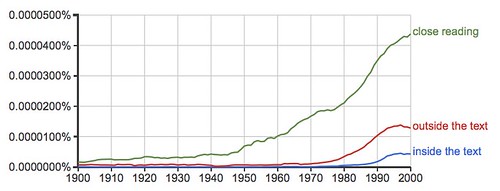
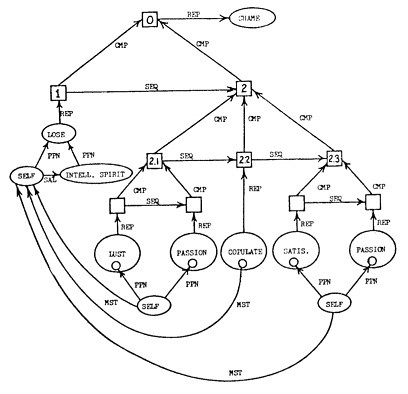
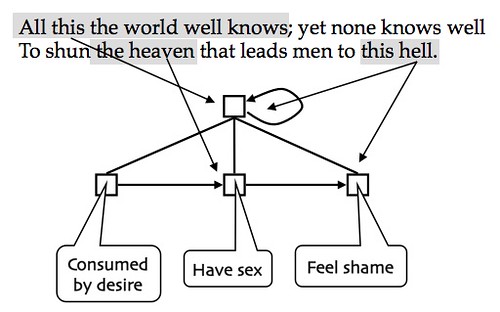
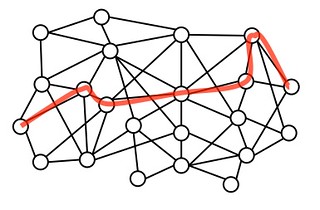
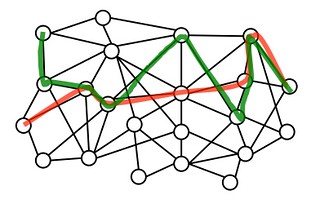
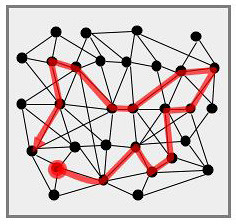

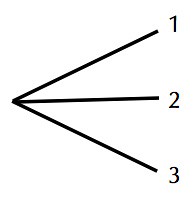
No comments:
Post a Comment